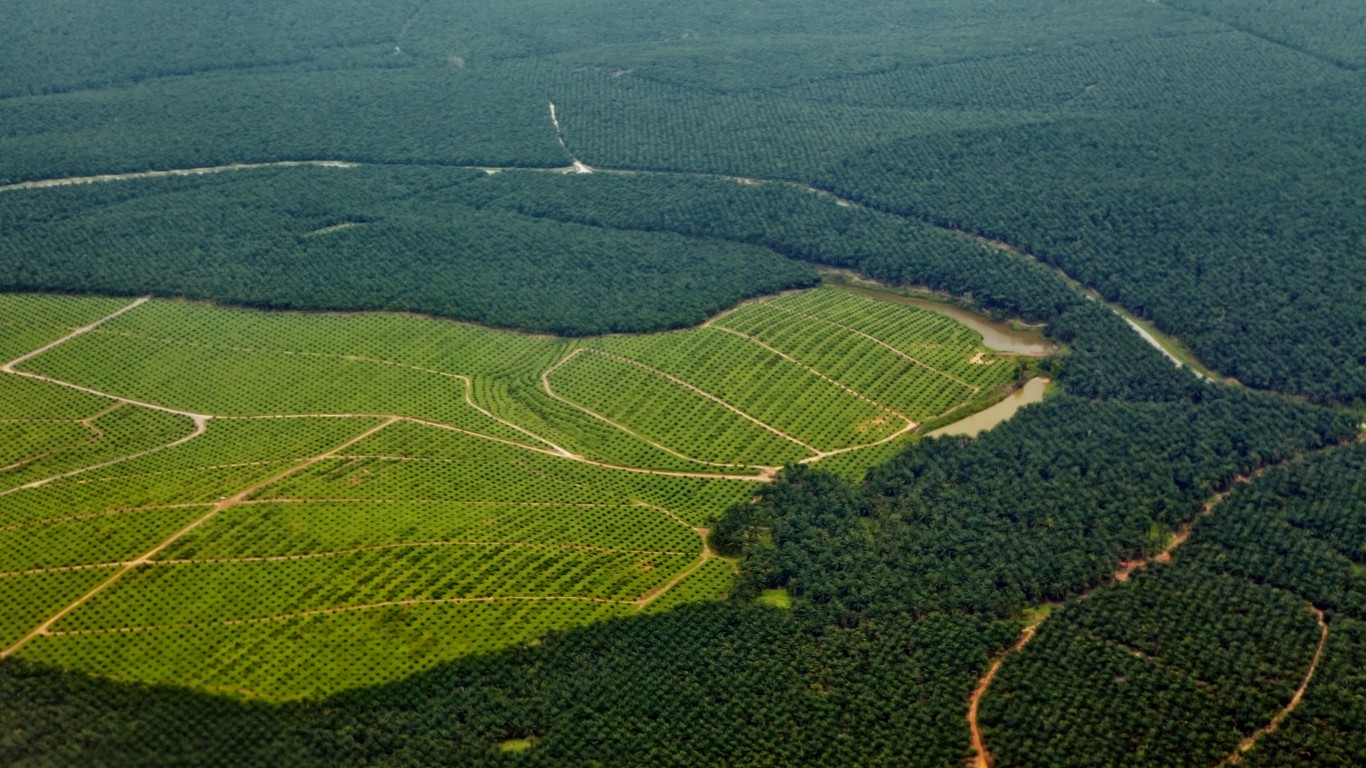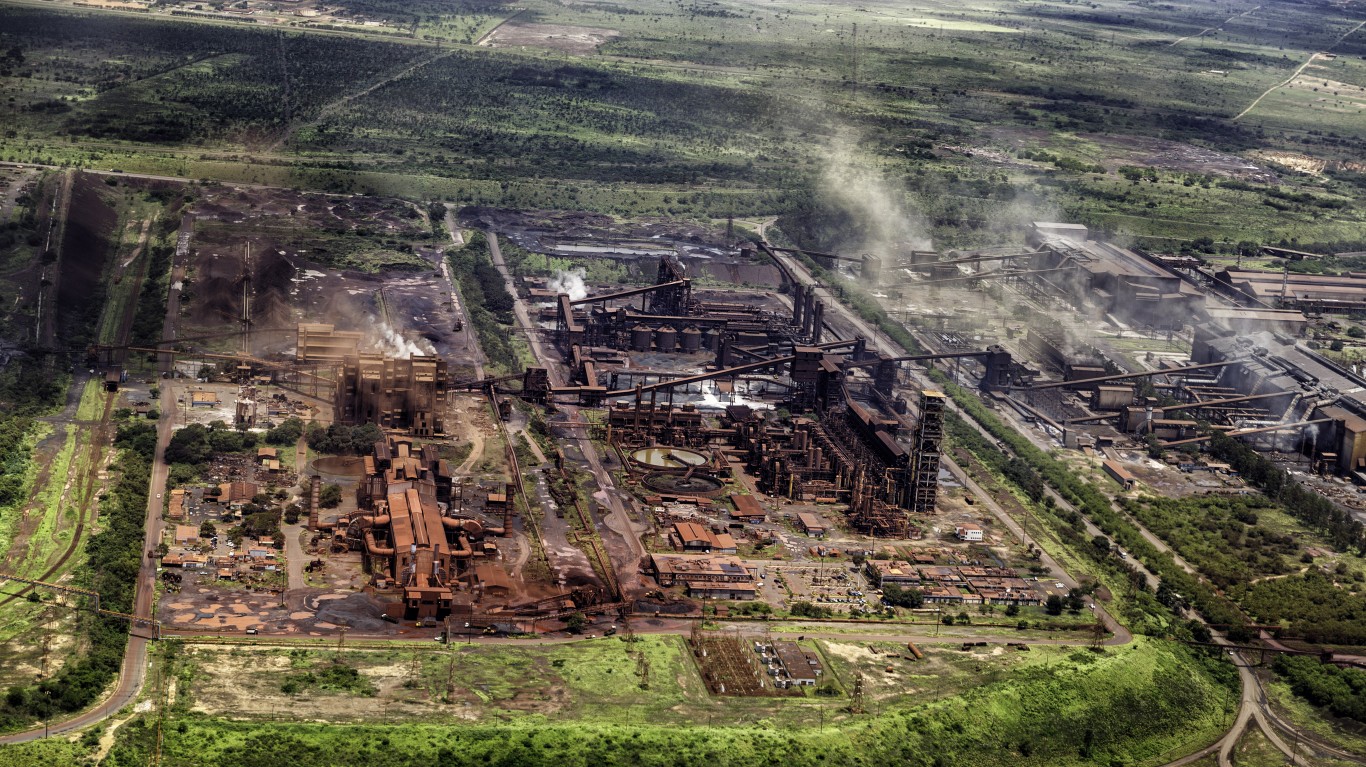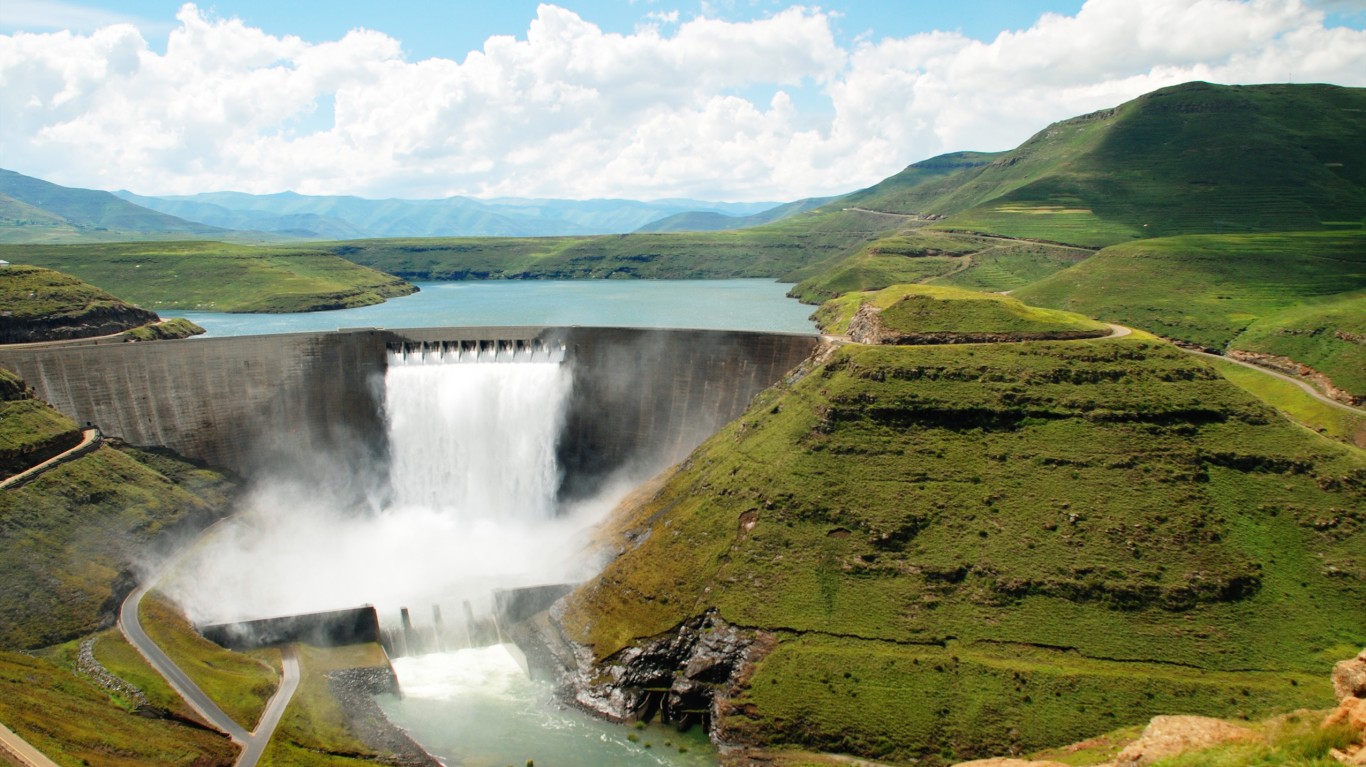Special Report
9 Industries Causing the Most Harm to the World’s Rainforests

Published:
Last Updated:

The Earth’s rainforests get smaller every year. The Amazonian rainforest, the largest on the planet, has lost approximately 305,000 square miles in the past 50 years, or 19% of the area it covered in 1970. An average of 5,600 square miles (about the size of Connecticut) has been deforested in the Amazon each year since then, with annual deforestation ranging from 11,219 square miles in 1995 to 1,765 square miles cut in 2012.
Rainforests are the home of indigenous peoples, as well as critical habitats for countless species of unique plants and animals. They contain enormous quantities of organic matter that make up some of the Earth’s largest stores of carbon, which if released would accelerate the climate crisis. (Learn some of the strategies that could avert climate disaster).
The planet’s rainforests also hold enormous economic value, providing timber, underground minerals, exotic fruits and animals, and an ideal climate for animal pasture and agriculture. Industrial activity to extract this value has increased dramatically in recent years.
Indonesia and Malaysia, which are home to some of the world’s largest tropical rainforests, alone produce over 90% of all palm oil consumed in the world. The Latin American nations of Argentina, Bolivia, Brazil and Paraguay — each country includes a portion of the Amazonian rainforest — account for nearly all the soybean and over 80% of beef exports from the continent.
To identify nine of the industries causing the most harm to the world’s rainforests, 24/7 Wall St. reviewed government sources such as Brazil’s National Institute of Space Research reports, research organizations such as Center for International Forestry Research, and recent studies published in environmental journals such as the environmental science journal Environmental Research Letters.
Click here to see the nine industries causing the most harm to the world’s rainforests.

Palm oil
The ideal growing conditions for oil palm are tropical climates with 70 to 90 inches of annual rainfall and 70 to 85 degrees Fahrenheit — the rainforest. The tropical fruit of the oil palm tree is one of the world’s most used vegetable oils. It can be used for frying and blends well with other oils, serves as the foaming ingredient in a range of soap products, is a natural preservative, and is cheap to produce.
Because of its economic value and a surge in demand for agricultural commodities, the pressure to grow the global palm oil industry is enormous. Global yearly production of palm oil grew from 33.5 million pounds in 1995 to 128.0 million pounds in 2015. The palm oil industry has become a major driver of economic growth and is touted as a source of alternative fuel. However, it also contributes massively to deforestation, biodiversity loss, forest fires, and other problems.
[in-text-ad]

Cattle ranching
Cattle ranching is one of the primary drivers of deforestation in tropical forests around the world. As global beef consumption has risen in recent years, farmers have increased ranching operations throughout the world’s rainforests. Much of the expansion has occurred in the Amazon, where 40% of Brazil’s cattle population is currently located. According to the Yale School of Forestry & Environmental Studies, cattle ranching is responsible for an estimated 80% of all deforestation in the Amazon region.
Because cattle ranching is a land-intensive activity — meaning the yield per unit of land is relatively low — it has a large impact on the environment. Poultry farming, for example, requires much less land for the same output as cattle, and grain farming requires just one-tenth of the land.

Soy
While soybeans are used in human food products like tofu, edamame, and soy milk, about 80% of the world’s soybean crop is used as animal feed. As incomes around the world rise and the global demand for meat increases, so does the demand for soy. Due to the increased demand — as well as recent advances in farming technology and crop genetics that allow soy to be grown in tropical climates — production of soy has more than doubled over the past 20 years. Much of the expansion in soybean cultivation has occurred in the Amazon and other tropical forests in Brazil, which is today the second largest producer of soy in the world.

Logging
Logging is the process of cutting down trees to produce timber and pulp for use in furniture, construction, and other wood products. As developing countries industrialize and demand for timber and pulp continues to rise, the scale and intensity of the global logging industry will continue to increase. Over the past 10 years, the amount of roundwood produced globally increased from 3.4 billion cubic meters to 3.9 billion cubic meters, an 18.8% increase.
In addition to causing deforestation, logging also has disruptive impacts on soil and hydrological cycles. The reduction in tree cover leads to increased water runoff and soil erosion and to a reduction in carbon capture capacity, which in turn contributes to climate change.
[in-text-ad-2]

Mining
Land cleared for mining operations reduces forest cover and contributes directly to deforestation. In addition, mining also causes pollution, infrastructure development, and increased human activity around the forested areas. According to the Yale School of Forestry & Environmental Studies, oil, gas, and mineral extraction account for approximately 7% of deforestation in subtropical countries.
Much of the deforestation and degradation is due to increased mining activity in ecologically sensitive areas such as the Amazon and Congo basins. In an October 2013 study published in the scientific journal Conservation Letters, researchers found that 25% of metal mines in Asia and South America and 44% of metal mines in Africa are located within 10 km (6.2 miles) of a protected area.

Poaching
While it is difficult to track illegal poaching activity, researchers estimate that approximately 100,000 elephants were killed for their ivory in East Africa between 2010 and 2012. Conservation charity Save the Rhino International estimates that roughly 9,000 African rhinos were lost to poaching in the last decade.
The harms of poaching go beyond the loss of biodiversity. According to one study published in the AAAS journal Science Advances, over-hunting contributes to forest carbon loss. Because poachers often target large animals responsible for the dispersion of fruits and seeds, eventually this could lead to the loss of the larger tree species responsible for storing the most carbon — leading to increased climate change.
[in-text-ad]

Paper
According to the World Wide Fund for Nature, 40% of industrial wood traded globally is used for pulp and paper products. While recent advances in the logging industry have introduced sustainable pulp harvesting techniques, paper production can lead to deforestation and degradation when not properly managed. The direct removal of trees for pulp harvesting leads to loss of forest cover, which can have disruptive impacts on soil and hydrological cycles as well as negative effects on the forest’s overall carbon sequestration capacity.
As developing nations industrialize, demand for paper products increases. Over the past two decades, the amount of pulpwood produced around the world has increased from 464.5 million cubic meters in 1998 to 686.1 million in 2018, a 47.7% jump.

Renewable energy
While biofuels are a viable, lower-emissions alternative to fossil fuels, the growing and harvesting of biofuels can lead to deforestation in ecologically sensitive areas when not properly managed. Crops used for biofuels require a large amount of land and have a relatively low energy yield. According to the United Nations Framework Convention on Climate Change, the harvesting of trees for fuel accounts for 5% of global deforestation.
In the Amazon, large hydroelectric dams contribute to deforestation through regular flooding, the displacement of major fish populations, and increased human activity. Dam turbines also churn methane-rich water from the bottom of a reservoir and spray it into the air, contributing to increased greenhouse gas emissions.

Industrial and subsistence farming
While indigenous peoples have used rainforests for subsistence agriculture for centuries, increased activity has put more stress on the forest, giving it less time to recover from slash-and-burn practices, ultimately leading to deforestation.
Although industrial agriculture has greater crop yield than most subsistence farming activities, the sector’s scale, monoculture production practices, and increased use of chemical fertilizers and pesticides has made it one of the main drivers of deforestation. According to the Yale School of Forestry & Environmental Studies, industrial and subsistence agriculture accounted for 80% of deforestation in tropical and subtropical countries from 2000 to 2010, primarily through soy, palm oil, and cattle ranching.
After two decades of reviewing financial products I haven’t seen anything like this. Credit card companies are at war, handing out free rewards and benefits to win the best customers.
A good cash back card can be worth thousands of dollars a year in free money, not to mention other perks like travel, insurance, and access to fancy lounges.
Our top pick today pays up to 5% cash back, a $200 bonus on top, and $0 annual fee. Click here to apply before they stop offering rewards this generous.
Flywheel Publishing has partnered with CardRatings for our coverage of credit card products. Flywheel Publishing and CardRatings may receive a commission from card issuers.
Thank you for reading! Have some feedback for us?
Contact the 24/7 Wall St. editorial team.